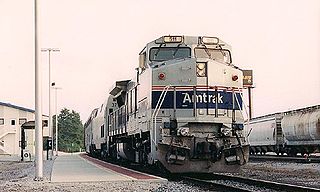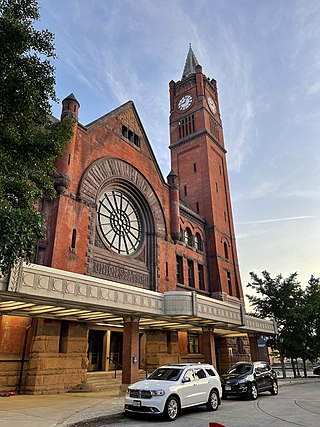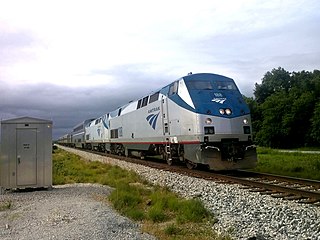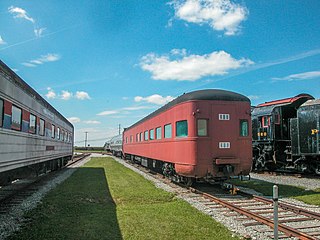
The City of New Orleans is a long-distance passenger train operated by Amtrak on an overnight schedule between Chicago and New Orleans. The train is a successor to the Illinois Central Railroad's Panama Limited.

The Broadway Limited was a passenger train operated by the Pennsylvania Railroad (PRR) between New York City and Chicago. It operated from 1912 to 1995. It was the Pennsylvania's premier train, competing directly with the New York Central Railroad's 20th Century Limited. The Broadway Limited continued operating after the formation of Penn Central (PC) in February 1968, one of the few long-distance trains to do so. PC conveyed the train to Amtrak in 1971, who operated it until 1995. The train's name referred not to Broadway in Manhattan, but rather to the "broad way" of PRR's four-track right-of-way along the majority of its route.

The City of Denver was a streamlined passenger train operated by the Union Pacific Railroad between Chicago, Illinois, and Denver, Colorado. It operated between 1936 and 1971. From 1936–1955 the Chicago and North Western Railway handled the train east of Omaha, Nebraska; the Chicago, Milwaukee, St. Paul and Pacific Railroad handled it thereafter. The train was the fastest long-distance train in the United States when it debuted in 1936, covering 1,048 miles (1,687 km) in 16 hours. For almost its entire career its principal competitor was the Chicago, Burlington and Quincy Railroad's Denver Zephyr. When Amtrak assumed operation of most intercity trains in the United States in 1971, it discontinued the City of Denver, preferring to use the Burlington's route between Chicago and Denver.

The Monon Railroad, also known as the Chicago, Indianapolis, and Louisville Railway from 1897 to 1971, was an American railroad that operated almost entirely within the state of Indiana. The Monon was merged into the Louisville and Nashville Railroad in 1971, and much of the former Monon right of way is owned today by CSX Transportation. In 1970, it operated 540 miles (870 km) of road on 792 miles (1,275 km) of track; that year it reported 1320 million ton-miles of revenue freight and zero passenger-miles.

The Cardinal is a long-distance passenger train operated by Amtrak between New York Penn Station and Chicago Union Station via Philadelphia, Washington, D.C., Charlottesville, Charleston, Huntington, Cincinnati, and Indianapolis. Along with the Capitol Limited and Lake Shore Limited, it is one of three trains linking the Northeast and Chicago. Its 1,146-mile (1,844 km) trip between New York and Chicago takes 281⁄4 hours.

The Kentucky Cardinal was a nightly 312-mile (502 km) passenger train operated by Amtrak from 1999 to 2003 between Chicago, Illinois, and Louisville, Kentucky, via Indianapolis, Indiana. On the three days that the Cardinal ran, the Kentucky Cardinal operated as a section, splitting at Indianapolis. On the other four days, it ran on its own to Chicago.

The Denver Zephyr was a streamlined passenger train operated by the Chicago, Burlington and Quincy Railroad between Chicago, Illinois, and Denver, Colorado. In peak years it ran to Colorado Springs. It operated from 1936 to 1973. The Denver Zephyr continued operating after the Burlington Northern Railroad merger in 1970. BN conveyed the train to Amtrak in 1971; Amtrak merged it with the Denver–Oakland City of San Francisco to form the San Francisco Zephyr and dropped the "Denver" name in 1973.

The Panama Limited was a passenger train operated from 1911 to 1971 between Chicago, Illinois, and New Orleans, Louisiana. The flagship train of the Illinois Central Railroad, it took its name from the Panama Canal, which in 1911 was three years from completion. For most of its career, the train was "all-Pullman", carrying sleeping cars only. The Panama Limited was one of many trains discontinued when Amtrak began operations in 1971, though Amtrak revived the name later that year and continued it until 1981.

The Indianapolis Union Station is an intercity train station in the Wholesale District of Indianapolis, Indiana. The terminal is served by Amtrak's Cardinal line, passing through Indianapolis three times weekly.

The Rocky Mountain Rocket was a streamlined passenger train of the Chicago, Rock Island and Pacific Railroad. Rock Island's train numbers 7 and 8 ran between Chicago's LaSalle Street Station and Denver's Union Station and Colorado Springs, Colorado. The Rocky Mountain Rocket ran from 1939 to 1966; the train was discontinued prior to the creation of Amtrak in 1971.

The Hoosier State was a 196-mile (315 km) passenger train service operated by Amtrak between Chicago and Indianapolis. It ran on the four days each week that the Cardinal did not run, giving daily rail service to the Chicago–Indianapolis corridor.

Mercury was the name used by the New York Central Railroad for a family of daytime streamliner passenger trains operating between midwestern cities. The Mercury train sets were designed by the noted industrial designer Henry Dreyfuss, and are considered a prime example of Streamline Moderne design. The success of the Mercury led to Dreyfuss getting the commission for the 1938 redesign of the NYC's flagship, the 20th Century Limited, one of the most famous trains in the United States of America.

The James Whitcomb Riley was a passenger train that operated between Chicago, Illinois, and Cincinnati, Ohio, via Indianapolis, Indiana. Originally operated by the New York Central Railroad, it was taken over by Amtrak in 1971. Under Amtrak, it merged with the Chesapeake & Ohio Railway's George Washington to become a Chicago-Washington/Newport News train. In 1977, it was renamed the Cardinal, which remains in operation.
The Lake Shore Limited was a passenger train service operated by the New York Central Railroad between New York City and Chicago, Illinois, from 1897 to 1956. Separate sections linked to Boston and St. Louis. The Lake Shore Limited was the New York Central's first luxury passenger train, and paved the way for its more famous cousin the 20th Century Limited. The 1897 name is now used by Amtrak's Lake Shore Limited, which follows much the same route.

The New England States was a passenger train operated by the New York Central Railroad and its successor Penn Central over the Water Level Route between Chicago and Boston. It was launched in 1938, in tandem with the relaunch of the newly-streamlined 20th Century Limited, and assumed responsibility for that train's Boston sleepers. In 1949 it became the first Chicago–Boston streamliner. The New York Central dropped the name in 1967; an unnamed remnant continued running until 1971. Amtrak's Lake Shore Limited now serves the route.

The Nickel Plate Limited, later known as the City of Cleveland and City of Chicago, was a passenger night train operated by the New York, Chicago and St. Louis Railroad between Chicago and Buffalo, New York via Cleveland, Ohio, with through service to Hoboken, New Jersey via Binghamton and Scranton and the Delaware, Lackawanna and Western Railroad for the Buffalo-Hoboken segment.

The Thoroughbred was a streamlined passenger train operated by the Chicago, Indianapolis and Louisville Railway (Monon) between Chicago, Illinois and Louisville, Kentucky via Monon, Indiana. It operated from 1948 to 1967. The Thoroughbred was the last passenger train operated by the Monon. It was named for the Thoroughbred horse breeds, a nod to the horse racing heritage of Louisville.

The Sun Lounges were a fleet of three streamlined sleeper-lounge cars built by Pullman-Standard for the Seaboard Air Line Railroad (SAL) in 1956. The cars featured a distinctive glazed roof area meant to capture the ambience of a dome car in a lower profile, as tunnels on the East Coast of the United States prevented the use of dome cars there. The Seaboard employed all three Sun Lounges on its flagship Silver Meteor between New York City and Miami, Florida. The cars later saw service with the Seaboard Coast Line Railroad (SCL) and Amtrak. Two of the three survive in private ownership.

The Erie Limited was a streamlined passenger train operated by the Erie Railroad between Jersey City, New Jersey and Chicago, Illinois via the Southern Tier. It operated from 1929 to 1963. After the merger of the Erie and the Delaware, Lackawanna and Western Railroad (DL&W) in 1960 it was known as the Erie-Lackawanna Limited. Once the premier passenger train on the Erie, repeated service reductions in the 1950s and 1960s left it a shell of its former self. The Phoebe Snow replaced it in 1963.

The View series was a fleet of six sleeper-observation lounges built by Pullman-Standard for use on the Pennsylvania Railroad's passenger trains. Pullman built four in 1938 and another two in 1949 after World War II. Their most prominent assignment was on the Broadway Limited, the Pennsylvania's flagship New York–Chicago train, but they were also assigned to the General and the Liberty Limited. Several of the cars have been preserved.




















